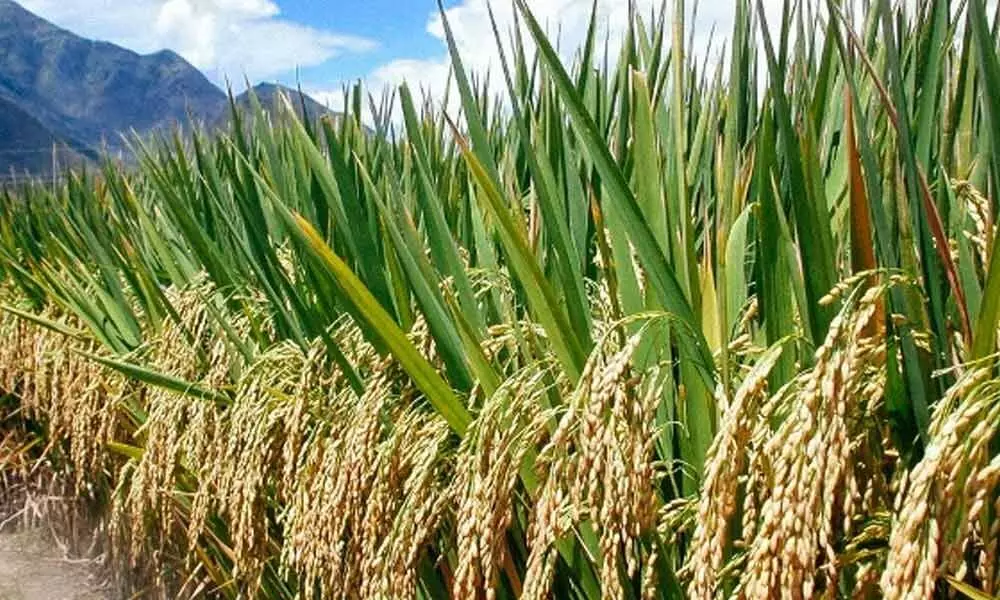Live
- Afghanistan: Six killed as vehicle falls into river in Badakhshan
- Complete failure in handling the situation: Congress on Sambhal violence
- Crucial UN plastics treaty talks begin in South Korea
- Delhi govt re-launched senior citizen pension scheme despite challenges: Bharadwaj
- PKL Season 11: We're determined to push for top spot in standings, says Puneri Paltan coach BC Ramesh
- Awareness Program on the Harmful Effects of Tobacco Products
- Bihar Assembly's winter session begins, three newly elected MLAs take oath
- Inflation to ease, economic growth to accelerate in coming months: Finance Ministry
- Protesters clash with police in J&K’s Katra town
- Senior Bengaluru Police Officer Accused in Suicide of Businesswoman S Jeeva
Just In
Diversifying from rice crop cultivation imperative


Diversifying from rice crop cultivation imperative
Climate change and the resultant global warming is bound to impact global heating significantly and hence it is better to stop relying on rice and wheat alone as staple foods in the country
Climate change and the resultant global warming is bound to impact global heating significantly and hence it is better to stop relying on rice and wheat alone as staple foods in the country. This is what a recent study found out. Alternative grains like millets and sorghum could help India cope better with the changed circumstances. There is, however, a key to successful shift from the current preferences. The area for cultivation of millets also must be selected carefully so that production shortfalls will not hamper our production goals, if at all we shift over.
An international team of scientists modelled crop cultivation and growth and found that, compared to finger millet, pearl millet and sorghum, rice yields are significantly more sensitive to inter-annual fluctuations in monsoon rainfall on both irrigated and rain-fed croplands. The team included scientists from universities in the US – University of Delaware, Columbia University, Yale University and Washington State University – and from the International Institute for Applied Systems Analysis, Laxenburg, Austria; and the Indian School of Business, Hyderabad.
In addition, a report launched on July 26 by the World Business Council for Sustainable Development (WBCSD) recommended diversification into millets to cope with climate change and malnutrition. The report referred to the huge impact that is possible across Asia and Africa where staples are typically 70 per cent of the plate and often refined and low in nutrition value.
Stating that the food systems rely heavily on five key commodities (wheat, rice, maize, potatoes and soy), often grown using intensive methods in a small number of breadbasket regions, it stated that intensive crop production of maize, rice and wheat has almost doubled over the past 50 years and today, these three commodities were the single most produced and consumed food products in the human diet, accounting for over 40 per cent of the world's calorie supply.
It is much higher in many countries, for example, in many parts of Asia rice alone can provide up to 80 per cent of caloric intake, as recognized in the report. The report highlighted the fact that diversifying staples is a key lever to food systems transformation to bring better nutrition and health to both people and our planet, and more resilience to farmers at the frontline of climate change. India is also under pressure on agricultural raw materials and the overall food resilience challenge is evolving as a risk to the country. The study suggested that to achieve staple diversification, only one or two crops could be focused on at one time to be able to build the required value chains locally to globally. Allocating more cropland to alternative grains can help stabilise grain production in a variety of climatic conditions.
Data Science specialists have noted, in addition, that the yields from grains such as millet, sorghum, and maize are more resilient to extreme events like droughts." On the other hand, the yield of rice – India's main crop – declines to a greater extent during extreme weather conditions. So by relying more and more on a single crop – rice – India's food supply is potentially vulnerable to the effects of varying climate. That should be a wake-up call to the Indian governments.

© 2024 Hyderabad Media House Limited/The Hans India. All rights reserved. Powered by hocalwire.com






